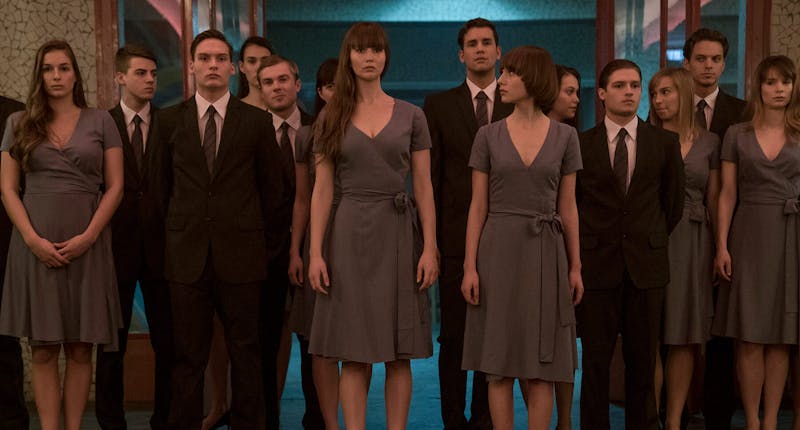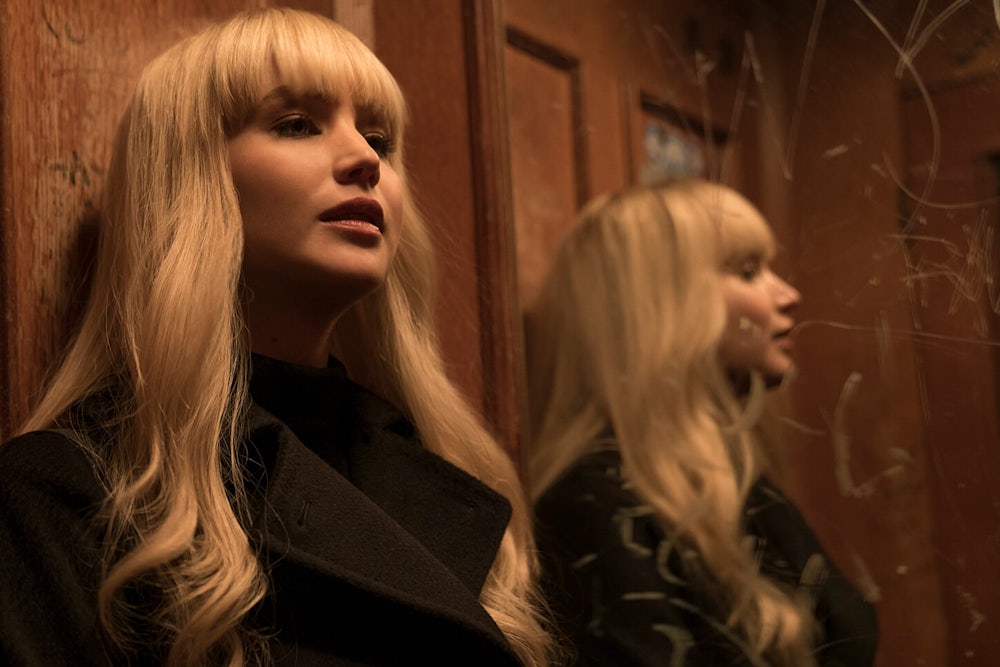Female interiority: Does it exist? Now take your answer, but imagine that the woman in question has bangs. The whole situation has changed, because there’s a layer—like a cognitive helmet—between you and the lady’s brain. Giving the female lead a fringe is a favorite move for many male directors. It’s a game of peekaboo. Now you see her (forehead), now you don’t. Red Sparrow, the latest picture from Francis Lawrence (The Hunger Games franchise, the videos for Shakira’s “Whenever, Wherever” and Avril Lavigne’s “Sk8er Boi”), is the latest in this distinguished tradition. The starring bangs (on Jennifer Lawrence) undergo a number of changes throughout the movie. What is the significance of this most custodial of haircuts in cinema, and what does that history mean for a movie like Red Sparrow, which is nominally about politics?
Lawrence plays Dominika Egorova, a Bolshoi ballerina who is convinced by her uncle to become a “sparrow.” The sparrows are based on “honey-pot” agents who ensnared male officials with their wiles during the Cold War (see: the Profumo affair). Trained in the art of seduction, the sparrows collect intelligence for the roughly present-day Russian state. Dominika’s mission is to establish contact with an American agent (Joel Edgerton) and find out the identity of his mole in Russia. Double-crossing and suspicious intimacy and lies-that-could-be-true ensue. What does Dominika really want? And which side is she on? Until the movie’s very end, the audience doesn’t know.
Dominika begins the movie with a blunt, brown fringe that skims her eyes. It symbolizes her humble background in a Moscow flat with her sick mother. Their apartment looks dusty. From early on, we see that Dominika has exceptional control over her face. Perhaps from her ballet training or perhaps because of her total patriotism, she is able to maintain an affect that is both charming and flat, like her hair.
The film’s imagining of the “sparrow school” is very camp in its starchy, uniform-wearing eroticism. I think it would probably offend me if I were Russian. Charlotte Rampling is the school’s “matron,” and she does lots of commanding youths to remove their clothes. Rampling, like Jennifer Lawrence, speaks in a cartoonish Russian accent. The whole movie sometimes seems like one big Russian accent. But Rampling’s is better than others’. “Americans are drrrunk on television and social media,” she intones, with a dark l on “social.”
Once Dominika begins her new life as a sparrow in the field, she gets a makeover. She has been through a couple of truly horrific rape scenes and some uncensored orthopedic surgery. Now stationed in Budapest, Dominika and her roommate Marta (Thekla Reuten) go to work with a single box of blonde hair dye. The results Dominika achieves are simply not possible. She comes out of that cold Hungarian bathroom with three heads’ worth of honey-streaked tresses. The bangs now curl softly under her eyebrows as if she had spent several hundred dollars on Olaplex and then had a conditioning treatment. No longer symbolizing poverty but instead the cruel glamor of international espionage, the bangs are now smooth.

These new blonde bangs do the same work as they did on Michelle Pfeiffer in Scarface and on Charlize Theron in Atomic Blonde: They transform the heroine into a deadpan, sexy cipher. When we cannot see the eyebrows of the woman, we cannot know the emotions of the eyebrows. Perhaps all bangs-cinema derives from Pfeiffer’s extraordinary turn as Elvira Hancock in Scarface, in that scene where Tony Montana is trying to get her attention on the dance floor. Montana pogoes behind her while she turns, and turns, and turns her back without any facial expression whatsoever. A blonde with long bangs has a literal shield protecting the part of the face that expresses anxiety and fear. They are a challenge to men—how will you know what I am thinking if you cannot see my face? Brown bangs, on the other hand—especially short brown bangs—are cute and childlike. They ask the question: Am I a woman, or am I a baby? For these bangs see Amelie, Funny Face, Léon: The Professional. Mia Wallace of Pulp Fiction turns those little bangs into something else: the dreadful insinuation of a baby gone bad.
Appearances are everything in Red Sparrow; they both hide and reveal. Dominika is forever using a hand mirror to apply concealer to bruises around her eyes. In the first few scenes, we see a number of different lights reflected in her eyes: the flashbulb of a photographer at the ballet, the expensive lights of a hotel room. By contrast, Joel Edgerton’s American agent spends the film’s early scenes in a dark park, melting into the shadows, suggesting that he is her mirror—they are opposites, procedurally, but somehow drawn to each other. Apart from Rampling, the movie’s best turn probably comes from Jeremy Irons as a General Korchnoi, who is an eerie Russian apparatchik. His motivations are unclear but his authority unquestioned, unquestionable. Korchnoi wears smoky dark glasses that we might call the transition-lenses of moral ambivalence.
In addition to her appearance, the idea of the Bolshoi ballet, with its excruciating rigor and discipline, does a great deal of work to characterize Dominika, whose motivations are otherwise solely represented by her unwell mother. Stereotypes about Russian ballerinas give her a sexuality that is performative and cold. Dominika can withstand great physical pain, even abuse, without flinching, and we sense that she has grown up knowing that beauty is supposed to hurt. There remains the possibility that all this performance is done out of dedication to the state. Or, perhaps, its opposite: like a young Rudolf Nureyev, the question that hovers over Dominika is whether she will jeté across to the West.
Cliché and symbol layer upon cliché and symbol, hiding the truth about Dominika until the final plot twist. In narrative terms, this works: We remain in suspense. We don’t know who is hiding what from whom. The emphasis on styling reinforces this dynamic, but it also inevitably takes away from the kind of characterization that marks an actually good spy movie. In the best of that genre—The Three Days of the Condor, The Ipcress File, Notorious—the lead actor must hold a lot back but, in private moments with the audience, give us all they’ve got. Espionage is a difficult business, and it helps if we can see your face.
